《计算机专业英语》谢希仁第二版-第1章讲义只是课件
- 格式:ppt
- 大小:1.34 MB
- 文档页数:24
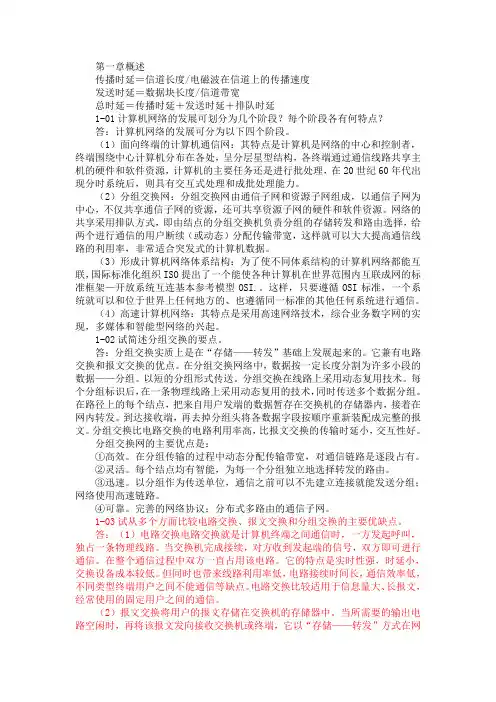
第一章概述传播时延=信道长度/电磁波在信道上的传播速度发送时延=数据块长度/信道带宽总时延=传播时延+发送时延+排队时延1-01计算机网络的发展可划分为几个阶段?每个阶段各有何特点?答:计算机网络的发展可分为以下四个阶段。
(1)面向终端的计算机通信网:其特点是计算机是网络的中心和控制者,终端围绕中心计算机分布在各处,呈分层星型结构,各终端通过通信线路共享主机的硬件和软件资源,计算机的主要任务还是进行批处理,在20世纪60年代出现分时系统后,则具有交互式处理和成批处理能力。
(2)分组交换网:分组交换网由通信子网和资源子网组成,以通信子网为中心,不仅共享通信子网的资源,还可共享资源子网的硬件和软件资源。
网络的共享采用排队方式,即由结点的分组交换机负责分组的存储转发和路由选择,给两个进行通信的用户断续(或动态)分配传输带宽,这样就可以大大提高通信线路的利用率,非常适合突发式的计算机数据。
(3)形成计算机网络体系结构:为了使不同体系结构的计算机网络都能互联,国际标准化组织ISO提出了一个能使各种计算机在世界范围内互联成网的标准框架—开放系统互连基本参考模型OSI.。
这样,只要遵循OSI标准,一个系统就可以和位于世界上任何地方的、也遵循同一标准的其他任何系统进行通信。
(4)高速计算机网络:其特点是采用高速网络技术,综合业务数字网的实现,多媒体和智能型网络的兴起。
1-02试简述分组交换的要点。
答:分组交换实质上是在“存储——转发”基础上发展起来的。
它兼有电路交换和报文交换的优点。
在分组交换网络中,数据按一定长度分割为许多小段的数据——分组。
以短的分组形式传送。
分组交换在线路上采用动态复用技术。
每个分组标识后,在一条物理线路上采用动态复用的技术,同时传送多个数据分组。
在路径上的每个结点,把来自用户发端的数据暂存在交换机的存储器内,接着在网内转发。
到达接收端,再去掉分组头将各数据字段按顺序重新装配成完整的报文。
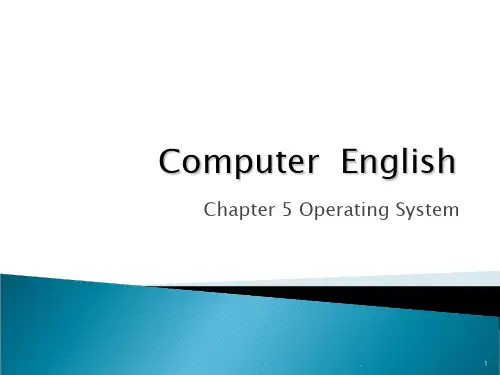
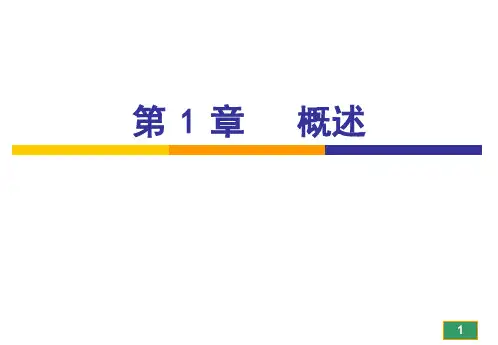
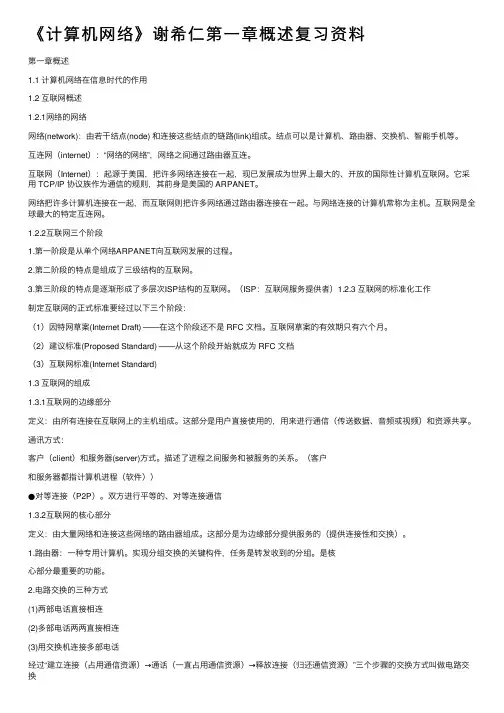
《计算机⽹络》谢希仁第⼀章概述复习资料第⼀章概述1.1 计算机⽹络在信息时代的作⽤1.2 互联⽹概述1.2.1⽹络的⽹络⽹络(network):由若⼲结点(node) 和连接这些结点的链路(link)组成。
结点可以是计算机、路由器、交换机、智能⼿机等。
互连⽹(internet):“⽹络的⽹络”,⽹络之间通过路由器互连。
互联⽹(Internet):起源于美国,把许多⽹络连接在⼀起,现已发展成为世界上最⼤的、开放的国际性计算机互联⽹。
它采⽤ TCP/IP 协议族作为通信的规则,其前⾝是美国的 ARPANET。
⽹络把许多计算机连接在⼀起,⽽互联⽹则把许多⽹络通过路由器连接在⼀起。
与⽹络连接的计算机常称为主机。
互联⽹是全球最⼤的特定互连⽹。
1.2.2互联⽹三个阶段1.第⼀阶段是从单个⽹络ARPANET向互联⽹发展的过程。
2.第⼆阶段的特点是组成了三级结构的互联⽹。
3.第三阶段的特点是逐渐形成了多层次ISP结构的互联⽹。
(ISP:互联⽹服务提供者)1.2.3 互联⽹的标准化⼯作制定互联⽹的正式标准要经过以下三个阶段:(1)因特⽹草案(Internet Draft) ——在这个阶段还不是 RFC ⽂档。
互联⽹草案的有效期只有六个⽉。
(2)建议标准(Proposed Standard) ——从这个阶段开始就成为 RFC ⽂档(3)互联⽹标准(Internet Standard)1.3 互联⽹的组成1.3.1互联⽹的边缘部分定义:由所有连接在互联⽹上的主机组成。
这部分是⽤户直接使⽤的,⽤来进⾏通信(传送数据、⾳频或视频)和资源共享。
通讯⽅式:客户(client)和服务器(server)⽅式。
描述了进程之间服务和被服务的关系。
(客户和服务器都指计算机进程(软件))●对等连接(P2P)。
双⽅进⾏平等的、对等连接通信1.3.2互联⽹的核⼼部分定义:由⼤量⽹络和连接这些⽹络的路由器组成。
这部分是为边缘部分提供服务的(提供连接性和交换)。
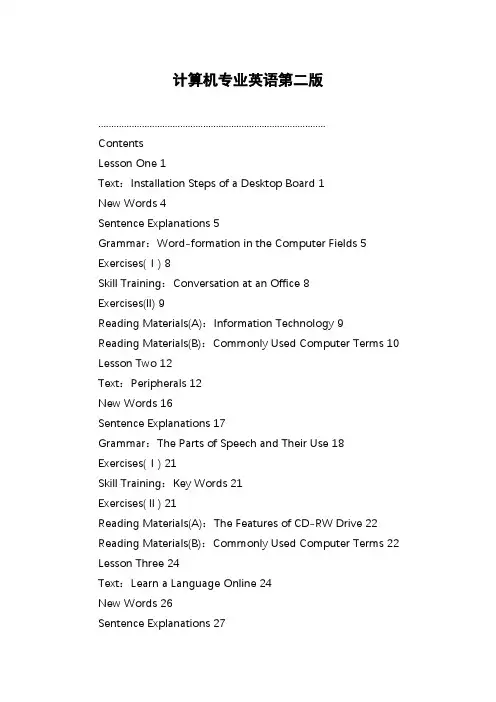
计算机专业英语第二版.........................................................................................ContentsLesson One 1Text:Installation Steps of a Desktop Board 1New Words 4Sentence Explanations 5Grammar:Word-formation in the Computer Fields 5 Exercises(Ⅰ) 8Skill Training:Conversation at an Office 8Exercises(II) 9Reading Materials(A):Information Technology 9Reading Materials(B):Commonly Used Computer Terms 10 Lesson Two 12Text:Peripherals 12New Words 16Sentence Explanations 17Grammar:The Parts of Speech and Their Use 18 Exercises(Ⅰ) 21Skill Training:Key Words 21Exercises(Ⅱ) 21Reading Materials(A):The Features of CD-RW Drive 22 Reading Materials(B):Commonly Used Computer Terms 22 Lesson Three 24Text:Learn a Language Online 24New Words 26Sentence Explanations 27Grammar:Verbs and the Components of a Sentence 27Exercises(Ⅰ) 29Skill Training:Abstract 30Exercises(Ⅱ) 32Reading Materials(A):China Races to Supplant India in Software 32Reading Materials(B):Commonly Used Computer Terms 34Lesson Four 35Text:Internet Morals Watchdog Guards Against Viruses as Well 35New Words 38Sentence Explanations 38Grammar:The Tenses 39Exercises(Ⅰ) 42Then and Now 42Skill Training:Business Card 43Exercises(Ⅱ) 46Reading Materials (A):Dont Bug Me! 46Reading Materials(B):Commonly Used Computer Terms 47Lesson Five 48Text:How the Internet Works 48New Words 50Sentence Explanations 51Grammar:The Passive Voice 52Exercises(Ⅰ) 53Skill Training:Superscription 53Exercises(Ⅱ) 55Reading Materials(A):Google Leading Role of Internet 55Reading Materials(B):Commonly Used Computer Terms 57Lesson Six 58Text:Voice Recognition Not Science Fiction 58New Words 61Sentence Explanations 62Grammar:The Subjunctive Mood 63Exercises(Ⅰ) 65Skill Training:Notice 67Exercises(Ⅱ) 68Reading Materials(A):Using a Modem 68Reading Materials(B):Commonly Used Computer Terms 70 Lesson Seven 71Text:Using Ants as Models for New Distributed Systems 71 New Words 74Sentence Explanations 74Grammar:The Infinitive 75Exercises(Ⅰ) 76Skill Training:The Structure of a Letter 78Exercises(Ⅱ) 81Reading Materials(A):End of the PC Era 81Reading Materials(B):Commonly Used Computer Terms 82 Lesson Eight 84Text:A New Programming Language Java 84New Words 86Sentence Explanations 88Grammar:Past Participle and Present Participle 88Exercises(Ⅰ) 89Skill Training:Commonly-used Opening Sentences and Closing Sentences of Letters 91Exercises(Ⅱ) 92Reading Materials(A):A Mobile Computer Team Services Sick Machines 92Reading Materials(B):Commonly Used Computer Terms 94Lesson Nine 95Text:Plug-and-Play Robots 95New Words 98Sentence Explanations 99Grammar:Gerund 100Exercises(Ⅰ) 101Skill Training:Letter Writing 102Exercises(Ⅱ) 104Reading Materials(A):A Guide to Computers and Plug-ins on the Internet 104Reading Materials(B):Commonly Used Computer Terms 106Lesson Ten 107Text:Caught in the Web of the Internet 107New Words 111Sentence Explanations 112Grammar:Non-finite Forms of Verbs 113Exercises(Ⅰ) 114Skill Training:Introduction to Company Organizations 115Exercises(Ⅱ) 116Reading Materials(A):Eleven Commandments by Bill Gates 117 Reading Materials(B):Commonly Used Computer Terms 118Lesson Eleven 119Text:Hackers Are Enemy Number One on the Internet 119New Words 121Sentence Explanations 122Grammar:Noun Clause 122Exercises(Ⅰ) 124Skill Training:Invitation Card 126Exercises(Ⅱ) 127Reading Materials(A):The Information Superhighway: From Expectationto Realization 127Reading Materials(B):Commonly Used Computer Terms 129Lesson Twelve 131Text:The Challenges of Using Search Agents to Perform Research on the World Wide Web 131New Words 134Sentence Explanations 135Grammar:Adjective Clause 135Exercises(Ⅰ) 137Skill Training:Job Interview 138Exercises(Ⅱ) 139Reading Materials(A):Safe Sex for Your Computer 139Reading Materials(B):Commonly Used Computer Terms 141Lesson Thirteen 143Text:Bill Gates Speech to Tsinghua University 143New Words 146Sentence Explanations 146Grammar:Adverbial Clauses 147Exercises(Ⅰ) 149Skill Training:Resume 151Exercises(Ⅱ) 154Reading Materials(A):Help! How Do I Set Up and Send an Online Resume 154Reading Materials(B):Commonly Used Computer Terms 156Lesson Fourteen 158Text:The Ancient History of the Internet 158New Words 162Sentence Explanations 162Grammar:Inverted Word-order 163Exercises(Ⅰ) 164Skill Training:Personal Statement 166Exercises(Ⅱ) 167Reading Materials(A):Father of Internet Surprised by 600 Million Followers 167Reading Materials(B):Commonly Used Computer Terms 168Lesson Fifteen 170Text:XPs Do-It-Yourself Security 170New Words 172Sentence Explanations 173Grammar:Complex Sentences Analysis 173Exercises(Ⅰ) 175Skill Training:Advertisement 175Exercises(Ⅱ) 176Reading Materials(A):One Number Gets It AllPhone, Fax or Voice Mail 177Reading Materials(B):Commonly Used Computer Terms 179Lesson Sixteen 181Text: Talk of Cooperation Is Out as the Software Industry Prepares forAnother Period of Sweeping Change 181New Words 184Sentence Explanations 184Grammar:Samples of Complex Sentences Analysis 186Exercises(Ⅰ) 187Skill Training:Agreement(Contract) 187Exercises(Ⅱ) 190Reading Materials(A):Just Imagine:What Computers Cant Do 190Reading Materials(B):Commonly Used Computer Terms 192Reference Translation and Answers 194Complex Exercises 270Bibliography 279。
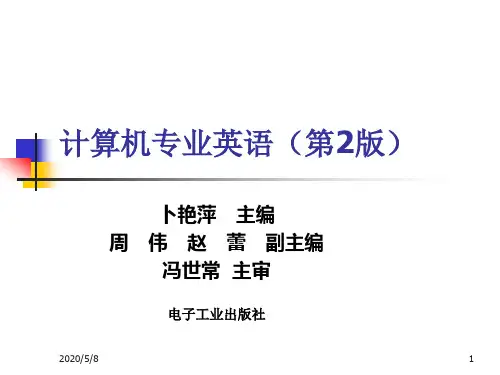
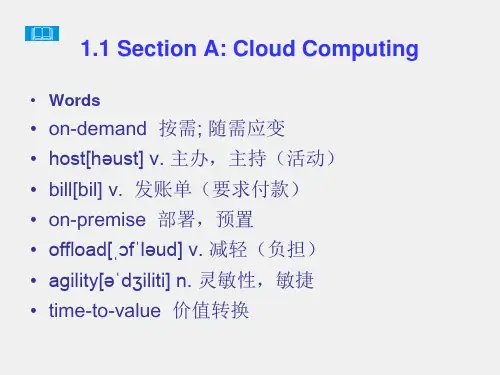

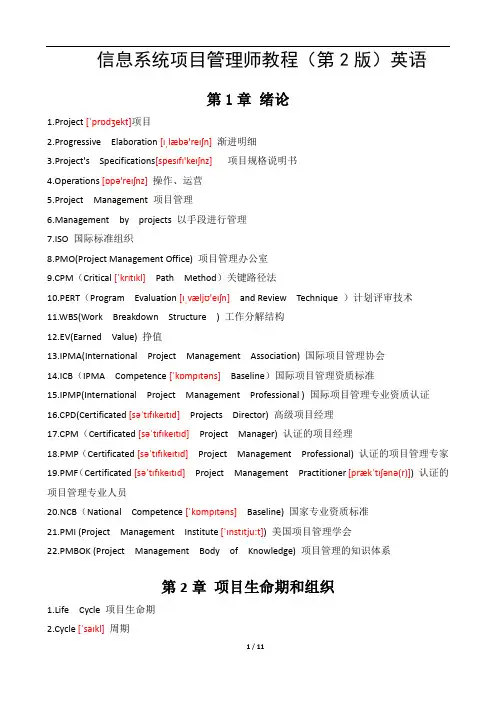
信息系统项目管理师教程(第2版)英语第1章绪论1.Project[ˈprɒdʒekt]项目2.Progressive Elaboration [ɪˌlæbə'reɪʃn]渐进明细3.Project's Specifications[spesɪfɪ'keɪʃnz]项目规格说明书4.Operations [ɒpə'reɪʃnz]操作、运营5.Project Management 项目管理6.Management by projects 以手段进行管理7.ISO 国际标准组织8.PMO(Project Management Office) 项目管理办公室9.CPM(Critical [ˈkrɪtɪkl]Path Method)关键路径法10.PERT(Program Evaluation [ɪˌvæljʊ'eɪʃn] and Review Technique )计划评审技术11.WBS(Work Breakdown Structure ) 工作分解结构12.EV(Earned Value) 挣值13.IPMA(International Project Management Association) 国际项目管理协会14.ICB(IPMA Competence [ˈkɒmpɪtəns]Baseline)国际项目管理资质标准15.IPMP(International Project Management Professional ) 国际项目管理专业资质认证16.CPD(Certificated [səˈtɪfɪkeɪtɪd]Projects Director) 高级项目经理17.CPM(Certificated [səˈtɪfɪkeɪtɪd]Project Manager) 认证的项目经理18.PMP(Certificated [səˈtɪfɪkeɪtɪd]Project Management Professional) 认证的项目管理专家19.PMF(Certificated [səˈtɪfɪkeɪtɪd]Project Management Practitioner[prækˈtɪʃənə(r)]) 认证的项目管理专业人员20.NCB(National Competence [ˈkɒmpɪtəns]Baseline) 国家专业资质标准21.PMI (Project Management Institute[ˈɪnstɪtju:t]) 美国项目管理学会22.PMBOK (Project Management Body of Knowledge) 项目管理的知识体系第2章项目生命期和组织1.Life Cycle 项目生命期2.Cycle[ˈsaɪkl]周期3.Phase[feɪz]阶段4.Iteration[ˌɪtəˈreɪʃn] 迭代5.Project Stakeholder[ˈsteɪkhəʊldə(r)]项目干系人,也称利害相关者6.Performing Organization 执行组织7.Project Team Members 项目团队成员8.Project Management Team 项目管理团队9.Sponsor [ˈspɒnsə(r)]出资人10.Influencer 有影响力的人第3章项目管理过程1.Initiating [ɪ'nɪʃɪeɪtɪŋ]Process Group 启动过程组2.Planning Process Group 规划过程组3.Executing [ɪ'nɪʃɪeɪtɪŋ] Process Group 执行过程组4.Monitoring and Controlling Process Group 监督和控制过程组5.Closing Process Group 收尾过程组第4章项目可行性研究与评估暂无第5章项目整体管理1.SOW(Statement of Work)工作说明书2.PMIS(project management information system) 项目管理信息系统第6章项目范围管理1.OBS(Organizational Breakdown Structure)组织分解结构2.BOM(Bill Of Material[məˈtɪəriəl])物料清单3.RBS(Risk Breakdown Structure)风险分解结构4.RBS(Resource [rɪˈsɔ:s] breakdown structure)资源分解结构第7章项目时间管理1.PDM(Precedence [ˈpresɪdəns]Diagramming ['daɪəgræmɪŋ]Method) 前导图法2.AON(Active On Node) 单代号网络图3.ADM(Arrow[ˈærəʊ]Diagramming['daɪəgræmɪŋ]Method) 箭线图法4.AOA(Active On Arrow ) 双代号网络图法5.Precede [prɪˈsi:d]Event 紧前事件6.Successor [səkˈsesə(r)]Event 紧后事件7.Dummy [ˈdʌmi] Activity 虚活动8.Gantt Chart [tʃɑ:t]甘特图也叫横道图或条形图(Bar Chart)9.Float 时差10.SV(Schedule[ˈʃedju:l]Variance[ˈveəriəns])进度偏差11.SPI(Schedule Performance Index) 进度绩效指数第8章项目成本管理1.AACEI( )国际成本协会2.Earned Value Management 挣值管理3.PV(The Planned Value) 计划值4.AC(Actual[ˈæktʃuəl]Cost)实际成本5.EV(Earned Value) 挣值6.CV(Cost Variance [ˈveəriəns])成本偏差7.SV(Schedule[ˈʃedju:l]Variance[ˈveəriəns]) 进度偏差8.CPI(Cost Performance Index) 成本绩效指数9.SPI(Schedule[ˈʃedju:l]Performance Index) 进度绩效指数10.EAC(Estimate [ˈestɪmət]At Completion [kəmˈpli:ʃn])完工估算第9章项目质量管理1.QC(Quality Control )质量控制2.UCL(Upper Control Limit)控制上限3.LCL(Lower Control Limit)控制下限4.Pareto 帕累托图5.Define 定义6.Measure[ˈmeʒə(r)]衡量7.Analyze ['ænəlaɪz]分析8.CTQ(Critical [ˈkrɪtɪkl]to Quality[ˈkwɒləti]) 质量关键要素第10章项目人力资源管理1.Forming 形成期2.Storming 震荡期3.Norming 为正规期4.Performing 表现期5.Legitimate[lɪˈdʒɪtɪmət] Power 合法的权力6.Coercive [kəʊˈɜ:sɪv] Power 强制力7.Expert Power 专家权力8.Reward Power 奖励权力9.Referent['refərənt]Power 潜示权力10.Problem Solving/Confrontaion 问题解决promising[ˈkɒmprəmaɪzɪŋ] 妥协12.Smoothing 求同存异13.Withdrawal[wɪðˈdrɔ:əl] 撤退14.Forcing 强迫第11章项目沟通管理1.CBO(Common Business Object) 通用业务对象第12章项目风险管理1.Ishikaw 因果分析图,也称鱼骨图2.Tornado [tɔ:ˈneɪdəʊ]Diagram 龙卷风图表3.EMV(Expected [ɪkˈspektɪd]monetary value analysis[əˈnæləsɪs])期望货币价值分析第13章项目采购管理1.RFP(Request For Proposal[prəˈpəʊzl]) 请求建议书2.RFQ(Request for quotation[kwəʊˈteɪʃn]) 请求报价单第14章合同管理暂无第15章配置管理1.CI(Configuration Item)配置项2.Configuration Management 配置管理B(Configuration Control Board)配置控制委员会estone [ˈmaɪlstəʊn]里程碑5.Configuration Library 配置库6.Configuration Item Repository [rɪˈpɒzətri]配置项库7.Development Library 开发库8.Controlled Library 受控库9.Product Library 产品库B(Change Control Board) 变更控制委员会11.Checkrequest 变更请求12.Draft [drɑ:ft]草稿13.Configuration Status Reporting 配置状态报告14.Repository 配置项库15.Configuration item 配置项第16章外包管理1.Contracting['kɒntræktɪŋ]out the activities 活动外包2.Outsourcing the service 服务外包3.Insourcing 内包4.Co-sourcing 合包5.Benefit-based relationship [rɪˈleɪʃnʃɪp] 利益关系6.The Specification[ˌspesɪfɪˈkeɪʃn]of Service 服务规格说明书7.Boundaries of Outsourcing 外包界限8.Arbitration [ˌɑ:bɪˈtreɪʃn]Process 仲裁流程9.Purchaser[ˈpɜ:tʃəsə(r)]购买者10.Risk Management 风险管理第17章需求管理1.Requirements Management 需求管理2.CMMI(Capability [ˌkeɪpəˈbɪləti] Maturity [məˈtʃʊərəti]Model® Integration) 能力成熟度模型集成3.Entry Criteria [kraɪ'tɪərɪə] 开始条件4.Verify [ˈverɪfaɪ]验证5.Exit Criteria [kraɪ'tɪərɪə]结束条件6.Certification [ˌsɜ:tɪfɪˈkeɪʃn] 审核7.Traceability [ˌtreɪsə'bɪlətɪ] Link跟踪能力(联系)链第18章职业道德规范1.Ethics 道德2.Professional Responsibility 职业道德第19章组织级项目管理与大型项目管理1.Project Portfolio [pɔ:tˈfəʊliəʊ]Management 项目组合管理anizational Process Assets 组织过程资产3.Statistical [stə'tɪstɪkl]Process Control 统计过程控制4.Special Cause 特殊原因mon Language 通用术语mon Processes 通用过程7.Singular [ˈsɪŋgjələ(r)]Methodolog 单一方法8.Benchmarking ['bentʃmɑ:kɪŋ]标杆分析法/基准化分析法9.Continuous [kənˈtɪnjuəs]Improvement 持续改进10.BestPractices 最佳实践11.Observable [əbˈzɜ:vəbl]Outcomes 可见的结果12.Key Performance Indicators ['ɪndɪkeɪtəz] 关键绩效指标13.Effectiveness [ɪˌfek'tɪvnɪs]效果14.Efficiency [ɪˈfɪʃnsi] 效率第20章战略管理概述1.Economic [ˌi:kəˈnɒmɪk]经济2.Social and cultural[ˈkʌltʃərəl] 社会和文化3.SCP (Structure, Conduct, Performance)结构,行为,性能4.Market Structure 市场结构5.Market Conduct 市场行为6.Market Performance 市场绩效7.Concentration [ˌkɒnsnˈtreɪʃn]Ratio 行业集中率8.EFE(External Factor Evaluation [ɪˌvæljʊ'eɪʃn]Matrix [ˈmeɪtrɪks]) 外部因素评价矩阵9.CPM(Competitive [kəmˈpetətɪv]Profile Matrix) 竞争态势矩阵10.IFE(Internal Factor Evaluation[ɪˌvæljʊ'eɪʃn] Matrix) 内部因素评价矩阵11.Strength[streŋθ]优势12.Weakness 劣势13.Opportunity[ˌɒpəˈtju:nəti] 机会14.Threats 威胁15.SPACE(Strategic [strəˈti:dʒɪk] Position And Action Evaluation[ɪˌvæljʊ'eɪʃn]) 战略地位与行动评价16.GSM(Grand [grænd]Strategy [ˈstrætədʒi]Matrix) 大战略矩阵17.BCG(Matrix: Boston Consulting Group) 波士顿矩阵18.QSPM(Quantitative [ˈkwɒntɪtətɪv]Strategic [strəˈti:dʒɪk]Planning Moment)定量战略计划矩第21章业务流程管理和重组1.BPM(Business Process Management) 业务流程管理2.BPR(Business Process Rebuilding) 业务流程重组3.Flow Charts 流程图法4.ABC(Activity Based Costing) 基于活动的成本计算法5.UML(Unified Modeling Language)统一建模语言6.Brainstorming 头脑风暴第22章知识管理1.Harvesting ['hɑ:vɪstɪŋ]采集2.Filtering ['fɪltərɪŋ] 过滤3.Dissemination [dɪˌsemɪ'neɪʃn] 传播4.WIPO(World Intellectual[ˌɪntəˈlektʃuəl] Property[ˈprɒpəti]Organization) 世界知识产权组织第23章项目整体绩效评估1.IRR(Internal Rate of Return) 内部收益率第24章信息安全系统和安全体系1.Warn 预警2.Protect 保护3.Detect 检测4.Response 反应5.Recover 恢复6.Counter-attack 反击7.MIS+S=Man agement Information System + Security “初级信息安全保障系统”或“基本信息安全保障系统”8.S-MIS=Security - Management Information System “标准信息安全保障系统”9.S2-MIS=Super Security - Management Information System “超安全的信息安全保障系统”第25章信息系统安全风险评估暂无第26章安全策略暂无第27章信息安全技术基础1.DES (Digital Encryption [ɪn'krɪpʃn] Standard) 数字加密标准2.Product Cipher ['saɪfə(r)]乘积密码3.IDEA (International Data Encryption [ɪn'krɪpʃn] Algorithm[ˈælgərɪðəm]) 国际数据加密算法4.RSA基于大数分解5.ECC (Elliptic [ɪ'lɪptɪk]Curve [kɜ:v]Cryptography [krɪpˈtɒgrəfi])椭圆曲线6.MD 信息摘7.DTS(Digital Time Stamp Service) 数字时间戳服务8.Service Provider 服务提供商9.STA(Stations) 基站10.AP(Access Points) 网络桥接器11.WEP(Wired Equivalent[ɪˈkwɪvələnt]Protocol) 连接对等协议12.WPA(Wi-Fi Protect Access) Wi-Fi保护接入第28章PKI公开密钥基础设施1.PKI (Public Key Infrastructure [ˈɪnfrəstrʌktʃə(r)])公开密钥基础设施2.CA (Certification Authority[ɔ:ˈθɒrəti]) 认证中心3.RA (Registration Authority) 注册机构4.KMC(Key Management Center) 密钥管理中心5.OU(Organizational Unit ) 组织单元6.Multi Level Hierarchy [ˈhaɪərɑ:ki]多层结构7.Fully Treed Architecture[ˈɑ:kɪtektʃə(r)]满树结构8.Hybrid[ˈhaɪbrɪd]Treed Architecture[ˈɑ:kɪtektʃə(r)]混合结构9.LDAP协议(Lightweight Directory[dəˈrektəri]Access Protocol)轻量级目录访问协议第29章PMI权限(授权)管理基础设施1.Authentication [ɔ:ˌθentɪ'keɪʃn]鉴别2.Authorization[ˌɔ:θəraɪˈzeɪʃn]授权3.MAC(Mandatory [ˈmændətəri] Access Control) 强制访问控制4.DAC(Discretionary [dɪˈskreʃənəri]Access Control) 自主访问控制5.Unclassified[ʌnˈklæsɪfaɪd]公开6.Restricted[rɪˈstrɪktɪd]受限7.Confidential[ˌkɒnfɪˈdenʃl]秘密8.Secret[ˈsi:krət]机密9.Top Secret 高机密10.PMI (Privilege[ˈprɪvəlɪdʒ]Management Infrastructure[ˈɪnfrəstrʌktʃə(r)]) 权限管理基础设施或授权管理基础设施11.RBAC (Role-Based Access Control) 基于角色的访问控制12.PDP(Policy Decision[dɪˈsɪʒn]Point ) 策略决策也叫授权策略服务器13. PEPs(Policy Enforcement[ɪn'fɔ:smənt]Points) 策略实施点第30章信息安全审计系统S-Audit1.Security Audit 安全审计第31章信息安全系统的组织管理暂无第32章信息安全系统工程ISSE-CMMrmation System Security Engineering 信息安全系统工程2.ISSE-CMM(Information Security System Engineering Capability Maturity Model )信息安全系统工程能力成熟度模型3.ISSE(Information security systems engineering)信息安全系统工程4.SSE(Systems Security Engineering) 系统安全工程5.SE(System Engineering ) 系统工程6.SA(System Acquisition[ˌækwɪˈzɪʃn]) 系统获取7.Engineering Organizations 工程组织8.Acquiring[ək'waɪərɪŋ]Organizations 获取组织9.Evaluation[ɪˌvæljʊ'eɪʃn]Organizations 评估组织10.Risk Process 风险过程11.Engineering Process 工程过程12.Assurance[əˈʃʊərəns] Process 保证过程13.GP(Generic Practices) 通用实施11 / 11。
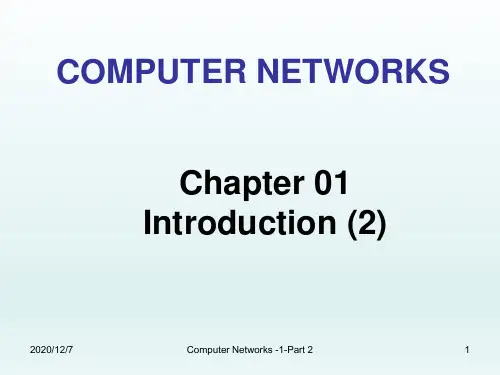
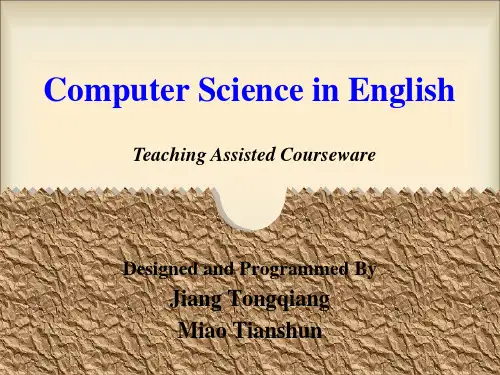
第二章物理层2-01 物理层要解决哪些问题?物理层的主要特点是什么?答:物理层要解决的主要问题:(1)物理层要尽可能地屏蔽掉物理设备和传输媒体,通信手段的不同,使数据链路层感觉不到这些差异,只考虑完成本层的协议和服务。
(2)给其服务用户(数据链路层)在一条物理的传输媒体上传送和接收比特流(一般为串行按顺序传输的比特流)的能力,为此,物理层应该解决物理连接的建立、维持和释放问题。
(3)在两个相邻系统之间唯一地标识数据电路物理层的主要特点:(1)由于在OSI之前,许多物理规程或协议已经制定出来了,而且在数据通信领域中,这些物理规程已被许多商品化的设备所采用,加之,物理层协议涉及的范围广泛,所以至今没有按OSI的抽象模型制定一套新的物理层协议,而是沿用已存在的物理规程,将物理层确定为描述与传输媒体接口的机械,电气,功能和规程特性。
(2)由于物理连接的方式很多,传输媒体的种类也很多,因此,具体的物理协议相当复杂。
2-02 规程与协议有什么区别?答:规程专指物理层协议2-03 试给出数据通信系统的模型并说明其主要组成构建的作用。
答:源点:源点设备产生要传输的数据。
源点又称为源站。
发送器:通常源点生成的数据要通过发送器编码后才能在传输系统中进行传输。
接收器:接收传输系统传送过来的信号,并将其转换为能够被目的设备处理的信息。
终点:终点设备从接收器获取传送过来的信息。
终点又称为目的站传输系统:信号物理通道2-04 试解释以下名词:数据,信号,模拟数据,模拟信号,基带信号,带通信号,数字数据,数字信号,码元,单工通信,半双工通信,全双工通信,串行传输,并行传输。
答:数据:是运送信息的实体。
信号:则是数据的电气的或电磁的表现。
模拟数据:运送信息的模拟信号。
模拟信号:连续变化的信号。
数字信号:取值为有限的几个离散值的信号。
数字数据:取值为不连续数值的数据。
码元(code):在使用时间域(或简称为时域)的波形表示数字信号时,代表不同离散数值的基本波形。